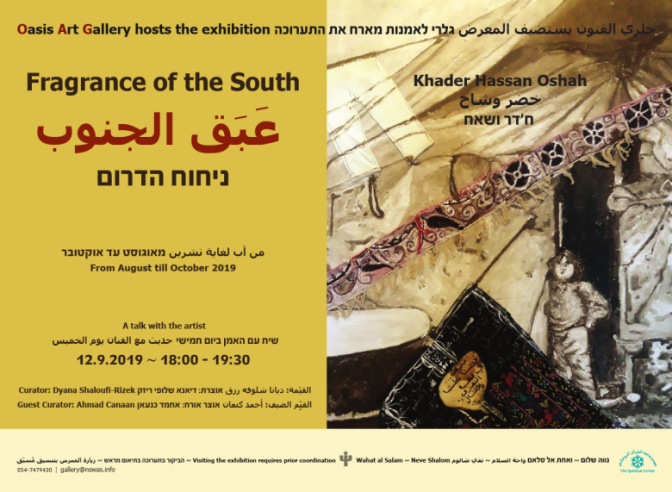Home > Oasis of Peace > Projects & Outreach > Art Gallery > Fragrance of the South
Fragrance of the South
Friday 1 November 2019, by

Fragrance of the South, a spotlight on the work of the Palestinian artist Khader Hassan Oshah. The exhibition is running from August through November. On September 12 there was a talk with the artist. The exhibition is co-curated by Dyana Shaloufi Rizek and artist Ahmed Canaan.
Khader Hassan Oshah
Born in 1966 to a Palestinian family in Al-Buriej refugee camp in the Gaza Strip. In 1989 he married Jawaher, a Bedouin woman from Rahat, moved to live with her in Rahat and obtained Israeli citizenship.
Oshaḥ began painting at a young age and continued during his high school years, using for the most part chalk as paint and doors, board and school walls as canvas. Between 2000 and 2004 he studied art at the visual arts center in Be’er al-Sabe’/Beer Sheva. In his art, Oshaḥ allows himself the freedom to travel between different methods and materials. His works move in the space between realism and expressionism: symbolic and minimalist lines, painting on canvas, carpets, animal skins, traditional embroidered cloth, run down wooden boards, tin boards, assemblage and found objects.
As an artist and as a human being, Oshaḥ deals with the conflicted state he is living in. In his work he deals with his national, cultural and religious identity, and his social life inside Israel.
“In my work I deal with my family memory and my nation’s past. That feeds my self-consciousness, which is also the familial and national consciousness. At the same time, I experience materials from reality, from television, the internet, dramatic events happening around me now which raise a desire to answer, cherish, document, illustrate and express.”
Oshaḥ’s paintings includes a collection of extremely expressive scenes, painted in vibrant or monochromatic colours, with expressive brushstrokes.
Mu’allaqat Series
The name mu’allaqat (lit. hanging) is taken from the hanging poems, the winners of poetry competitions in the ‘Okadh market which would then be hung up next to or on the Ka’bah. Oshaḥ paints his face alongside his family’s and friends’ both near and in the diaspora. The background is ornamental with embroidery and poems from the greatest poets such as Mahmoud Darwish, Ahmad Mattar, Nizar Qabbani and others. This series is for the most part drawn on animal skin.
The writing on the skin references the writing of the mu’allaqat on animal skin. Through the work the artist expresses his longing for his family members spread through Gaza, the West Bank, the Gulf, Jordan and Sinai, and is a tribute to his favourite poets.
Several characters have iconic characteristics, emphasized by the work on the background which included painting and engraving of an ornamental pattern. Some were drawn through direct observation, others from photographs.
Hajar Series
In this series, Oshaḥ deals with the subject of a burning personal and collective trauma he experienced childhood.
“I tried to forget what happened to my aunt on the subject of family honor, some of the things I saw with my own eyes. Through painting I tried to understand what is happening in our society, because we can’t comprehend some of the difficult events which we live through.”
In the series, Khader uses the embroidered qabbeh (the central chest piece of the traditional dress), literary texts and a red circle to emphasize a number designating the woman life years before being murdered by a man.
Each artwork forms a document and witness: a woman lived and died.
The qabbeh forms an encrypted identification card, coded with embroidered symbols which reflect the social class, the family status and the geographic location.
Khader Oshaḥ, the male artist, chose the traditional products created by the hands of women throughout generations to express the force of their cry. Meanwhile, spread over a black background, are the poems of Nidaa Khoury and Mahmoud Darwish.
Refugees Series
Historical images of refugees, immigration and expulsion, known to Wishaḥ from faded, yellowing photographs of his family and his people. Faded brown-black-white tones take over these paintings. A history that repeats itself in a different place around the world to the point where photos from 1948 look like those from the last decade in many places around the Middle East.
Family Series
Khader paints characters from his family through direct observation or by looking at photographs. He tries to safeguard memories and close the gaps of distance, time and longing.
“I try to document family faces not only in my memory, but also in my surroundings, in Rahat. I want everyone to know my family members, even if they can’t meet them. I want them to be there around us, at home, among family members and among the children.”
Photo Album
